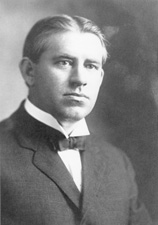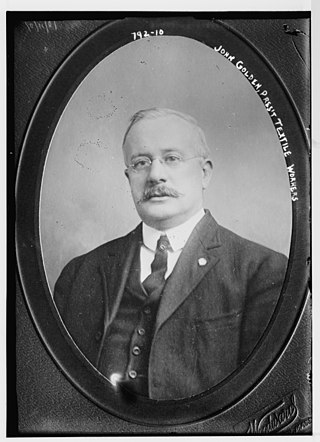
William Dudley Haywood, nicknamed "Big Bill", was an American labor organizer and founding member and leader of the Industrial Workers of the World (IWW) and a member of the executive committee of the Socialist Party of America. During the first two decades of the 20th century, Haywood was involved in several important labor battles, including the Colorado Labor Wars, the Lawrence Textile Strike, and other textile strikes in Massachusetts and New Jersey.
The United States textile workers' strike of 1934, colloquially known later as The Uprising of '34 was the largest textile strike in the labor history of the United States, involving 400,000 textile workers from New England, the Mid-Atlantic states and the U.S. Southern states, lasting twenty-two days.

The Lawrence Textile Strike, also known as the Bread and Roses Strike, was a strike of immigrant workers in Lawrence, Massachusetts, in 1912 led by the Industrial Workers of the World (IWW). Prompted by a two-hour pay cut corresponding to a new law shortening the workweek for women, the strike spread rapidly through the town, growing to more than twenty thousand workers and involving nearly every mill in Lawrence. On January 1, 1912, the Massachusetts government enforced a law that cut mill workers' hours in a single work week from 56 hours, to 54 hours. Ten days later, they found out that pay had been reduced along with the cut in hours.

The Textile Workers Union of America (TWUA) was an industrial union of textile workers established through the Congress of Industrial Organizations in 1939 and merged with the Amalgamated Clothing Workers of America to become the Amalgamated Clothing and Textile Workers Union (ACTWU) in 1976. It waged a decades-long campaign to organize J.P. Stevens and other Southern textile manufacturers that achieved some successes.

Joseph James "Smiling Joe" Ettor (1885–1948) was an Italian-American trade union organizer who, in the middle-1910s, was one of the leading public faces of the Industrial Workers of the World. Ettor is best remembered as a defendant in a controversial trial related to a killing in the seminal Lawrence Textile Strike of 1912, in which he was acquitted of charges of having been an accessory.
The following is a timeline of labor history, organizing & conflicts, from the early 1600s to present.

William Hughes was an American politician of Irish origin. A member of the Democratic Party, he served in both houses of the United States Congress as the U.S. representative for New Jersey's 6th congressional district from 1903 to 1905 and again from 1907 to 1912 and a United States senator from New Jersey from 1913 to 1918.

The 1913 Paterson silk strike was a work stoppage involving silk mill workers in Paterson, New Jersey. The strike involved demands for establishment of an eight-hour day and improved working conditions. The strike began in February 1913, and ended five months later, on July 28. During the course of the strike, approximately 1,850 strikers were arrested, including Industrial Workers of the World (IWW) leaders Bill Haywood and Elizabeth Gurley Flynn.

Anna LoPizzo was an Italian immigrant striker killed during the Lawrence Textile Strike, considered one of the most significant struggles in U.S. labor history.

Emil Rieve was an American labor leader. He was president of the Textile Workers Union of America (TWUA) from 1939 to 1956, a vice president of the Congress of Industrial Organizations (CIO) from 1939 to 1955, and a vice president of the AFL-CIO from 1955 to 1960.

The 1926 Passaic textile strike was a work stoppage by over 15,000 woolen mill workers in and around Passaic, New Jersey, over wage issues in several factories in the vicinity. Conducted in its initial phase by a "United Front Committee" organized by the Trade Union Educational League of the Workers (Communist) Party, the strike began on January 25, 1926, and officially ended only on March 1, 1927, when the final mill being picketed signed a contract with the striking workers. It was the first Communist-led work stoppage in the United States. The event was memorialized by a seven reel silent movie intended to generate sympathy and funds for the striking workers.

Arthur Patrick L. "Pat" Quinlan (1883–1948) was an Irish trade union organizer, journalist, and socialist political activist. Quinlan is best remembered for the part he played as an organizer for the Industrial Workers of the World in the 1913 Paterson silk strike — an event which led to his imprisonment for two years in the New Jersey State Penitentiary.

Anne Burlak Timpson was an early twentieth-century leader in labor organizing and leftist political movements. A member of the National Textile Workers Union and Communist Party, Burlak was jailed numerous times for sedition. Based in New England for much of her adult life, Burlak was a candidate for local and state offices in Rhode Island and played a major role in crafting the National Recovery Administration's workplace standards for textile unions during the New Deal era.
The Lawrence Textile Strikes were part of a series industrial strikes in the garment and textile industries of the American East from 1909 to 1913. The participants of these strikes were largely immigrant factory workers from southern and eastern Europe. Class division, race, gender, and manufacturing expertise all caused internal dissension among the striking parties and this led many reformist intellectuals in the Northeast to question their effectiveness. A major turning point for these labor movements occurred in 1912 during the Lawrence Textile Strike in Lawrence, Massachusetts, where laborers were able to successfully pressure mill owners to raise wages, later galvanizing support from left-leaning intellectual groups. In 1913 the Paterson Silk Strike also referred to as the Lawrence Textile Strike of 1913 took place in Paterson, New Jersey. This strike was a work stoppage involving silk mill worker.

The 1907 Skowhegan textile strike was a labor dispute between approximately 225 mill workers and the owners of the Marston Worsted Mill in Skowhegan, Maine, United States. Declared following the firing of 17 year-old French Canadian-American girl named Mamie Bilodeau, the strike was the first successful strike involving the recently formed Industrial Workers of the World.

John Golden was an American textile worker and trade union leader. He was elected president of the United Textile Workers of America (UTW) each year from 1902 until shortly before his death in 1921. At the time of his death, he was declared as important to textile unionism as John Mitchell was to mining unionism.
The 1914–1915 Fulton Bag and Cotton Mills strike was a labor strike involving several hundred textile workers from the Fulton Bag and Cotton Mills in Atlanta, Georgia, United States. The strike, which involved about 500 millworkers, began on May 20, 1914, and ended almost a year later on May 15, 1915, in failure for the strikers.

The 1912–1913 Little Falls textile strike was a labor strike involving workers at two textile mills in Little Falls, New York, United States. The strike began on October 9, 1912, as a spontaneous walkout of primarily immigrant mill workers at the Phoenix Knitting Mill following a reduction in pay, followed the next week by workers at the Gilbert Knitting Mill for the same reason. The strike, which grew to several hundred participants under the leadership of the Industrial Workers of the World (IWW), lasted until January the following year, when the mills and the strikers came to an agreement that brought the workers back to the mills on January 6.

The New England Textile Strike was a strike led by members of the United Textile Workers of America (UTW) principally in the U.S. states of Massachusetts, New Hampshire, and Rhode Island. Throughout the duration of the strike, an estimated 68,000-85,000 workers refused to work. Alongside the UTW, the IWW and ATW played major organizing roles within it, with the strike lasting for around 200 days at most mills.

Horace A. Riviere (1887–1942) was an influential labor leader as the 4th Vice President of the Textile Workers Union of America and head of the New England district of the United Textile Workers of America during a crucial period in American industrial history. Known for his dedication to improving working conditions, advocating for labor rights, and championing the cause of textile workers, Riviere played a pivotal role in shaping the labor movement in the early to mid-20th century...
















